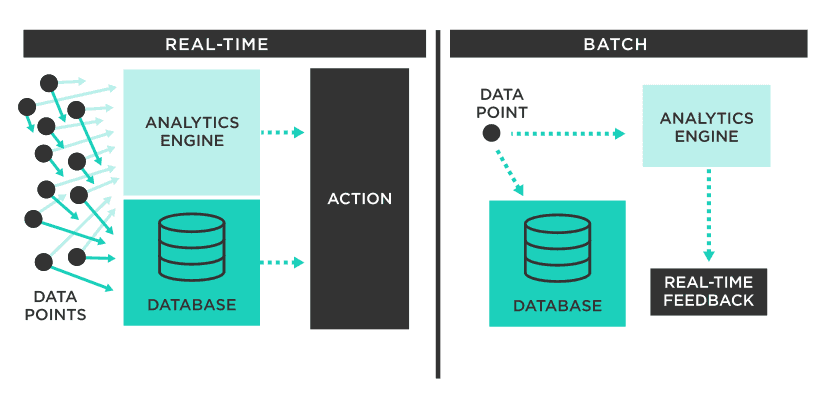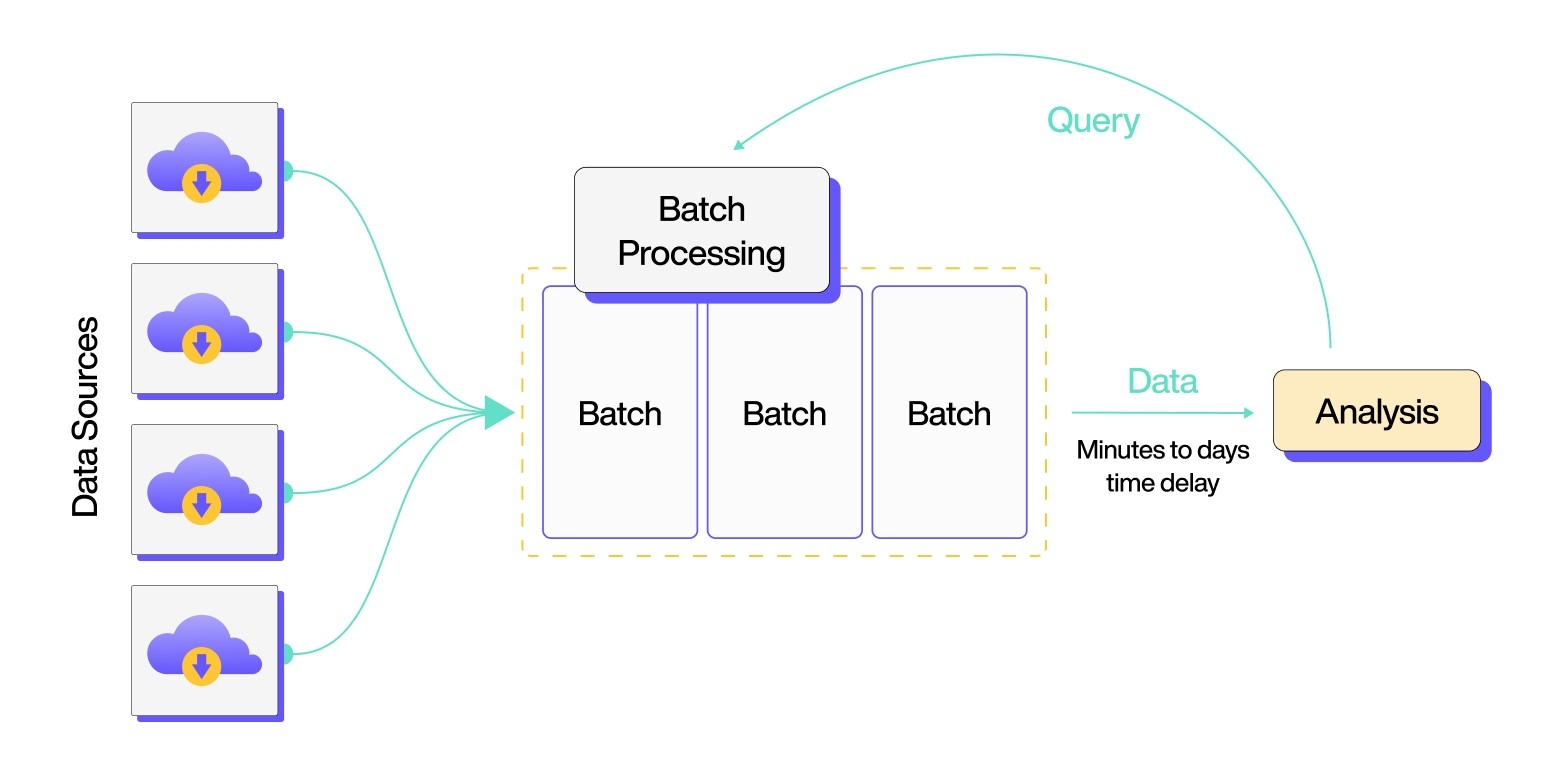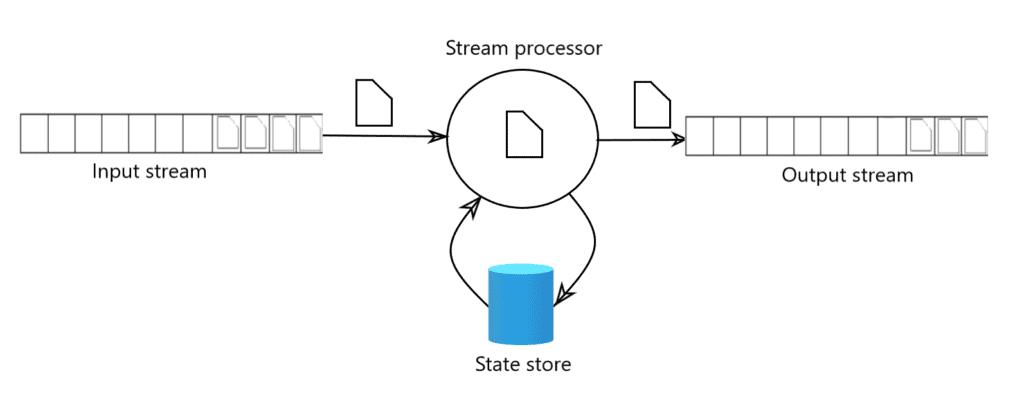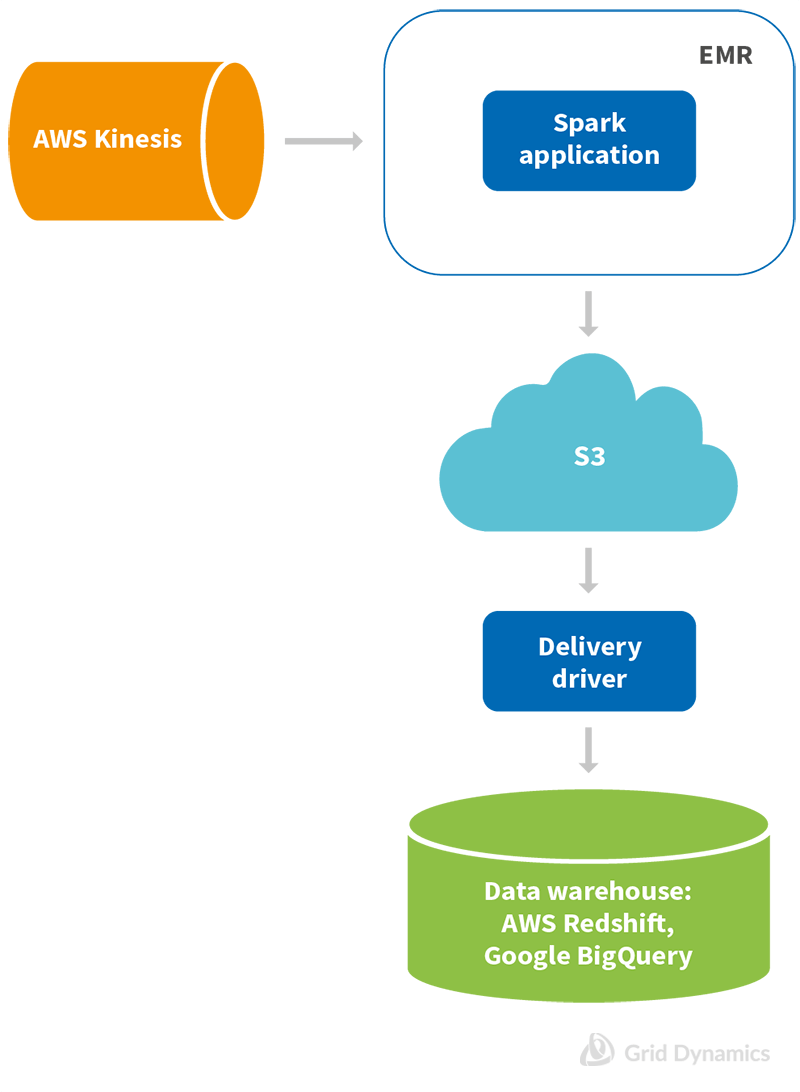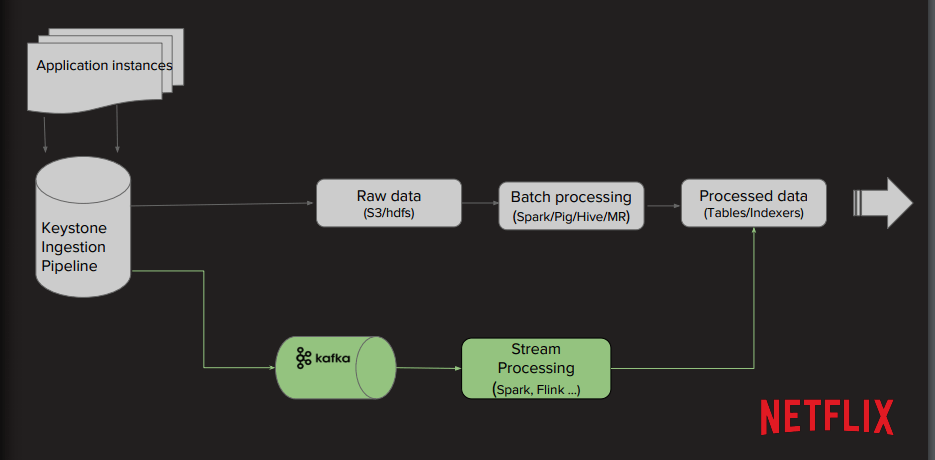
For any data-driven business, managing huge volumes of information from multiple sources is an ongoing challenge. As the speed and complexity of data grow, organizations face a critical decision: Should we process data in real time or in scheduled batches? This question fuels the ongoing debate around batch processing vs stream processing.
Batch processing is the bulk processing of data at predefined intervals.
Stream processing continuously ingests and analyzes data in real time, often within milliseconds.
This distinction matters more than ever, especially as 80–90% of newly generated data is unstructured, flowing in from sources like IoT devices, user activity logs, sensors, and third-party APIs. Businesses must choose a processing model that can effectively handle both scale and speed.
In this guide, we’ll break down:
- The difference between batch and stream processing
- The pros and cons of each model
- Use cases across industries like healthcare, logistics, finance, and media
- Real-world examples of companies switching from batch to stream
- How platforms like Estuary Flow support both approaches with flexibility and ease
Whether you're building your first data pipeline or re-architecting your stack for real-time analytics, this guide will help you choose the right approach for your data strategy.
What is Batch Processing: A Guide To Processing Data In Bulk
Batch processing is a data processing method where large volumes of data are collected over a set period, grouped into a “batch,” and processed together at a later time—rather than immediately as the data is generated.
This model has been foundational in traditional data architectures and remains widely used today, especially in data warehousing, billing systems, end-of-day reporting, and other high-volume, non-urgent workflows.
How Batch Processing Works
In batch processing, data is accumulated in storage systems such as file servers, cloud storage, or relational databases. Once the batch reaches a certain threshold or a trigger time (e.g., midnight), it’s fed into a processing system for analysis, transformation, or reporting.
This makes batch ideal for deep data analysis and resource scheduling, but it comes with trade-offs in latency and flexibility.
Think of it like doing laundry: You don’t wash every sock as soon as it gets dirty—you wait until there’s a full load.
Batch Processing Pros
Batch processing, with its automated and systematic approach, provides many advantages for businesses. Let’s look into these benefits to better understand the importance of batch processing in today’s world.
- Offline features: Unlike some systems that require consistent online connectivity, batch processes can be executed at any time, irrespective of online or offline settings.
- Improved data quality: Batch processing enhances the accuracy of data. As the process is mostly automated, it minimizes manual interventions and reduces human errors.
- Hands-off approach: It is designed for minimal supervision. Once the system is operational, it’s self-sufficient. When issues arise, the system sends alerts to the right people, so they don’t have to monitor it constantly.
- Greater efficiency: To smartly manage your tasks, you can schedule processing jobs only when resources are available. This method lets you prioritize urgent tasks while less immediate jobs can be allocated for batch processing.
- Simplified system: There’s no need for specialized hardware, constant system support, or complicated data entry, simplifying the overall process. This method's automatic process and low maintenance requirements make it easy for your team to switch to batch processing.
Batch Processing Cons
While batch processing has its benefits, it’s important to consider its limitations to make a well-rounded decision. Let’s look at some of the most common challenges associated with batch processing.
- Debugging and maintenance: Batch processing systems are challenging to maintain. Even small errors or data issues can escalate quickly and ground the entire system.
- Dependency on IT specialists: Batch processing systems have inherent complexities. So, you’ll often need IT experts to debug and fix them which can be a constraint for business operations.
- Manual interventions: Despite the automation capabilities, batch processing sometimes needs manual tuning to meet specific requirements. These manual interventions cause inconsistencies, potential errors, and increased labor costs.
- Unsuitability for real-time processing: Given its inherent latency, batch processing is not suitable for real-time data handling. This means for tasks that require instantaneous insights or timely data feedback, batch processing might not be the optimal choice.
- Deployment and training: Using batch processing technologies needs special training. It's not just about setting up the technology; you should make sure that managers and staff are ready to handle batch triggers, understand exception notifications, and schedule processing tasks effectively.
While not suitable for real-time decision-making, batch processing remains valuable for historical analysis, cost-optimized compute, and legacy system compatibility.
What Is Stream Processing: Understanding Real-Time Data Processing
Stream processing is a method of continuously ingesting, analyzing, and acting on data in real time, as soon as it’s generated or received.
Unlike batch processing, which waits for data to accumulate, stream processing handles data as a constant flow, enabling low-latency decisions and actions. This method is ideal for use cases where milliseconds can make a difference, such as fraud detection, personalized content, or monitoring systems.
According to a recent Gartner Peer Community poll, 83% of organizations are using real-time streaming pipelines, compared to just 33% for batch processing and 32% for Lambda architecture.
How Stream Processing Works
Stream processing systems break incoming data into small packets or micro-batches, analyze them as they arrive, and immediately trigger insights, alerts, or storage actions. These systems often integrate with event streaming platforms like Apache Kafka, Apache Flink, or real-time data pipeline tools like Estuary Flow.
The data doesn't wait. It flows, gets processed instantly, and enables action right when it matters.
Stream Processing Pros
Let’s discuss the significant benefits of stream processing and understand why it’s becoming an essential tool in modern data operations.
- Efficient data handling: Stream processing has a consistent, real-time approach to data analytics. It swiftly identifies and retains the most important information.
- Enhanced data security: Stream processing minimizes
potential discrepancies in data handling while prioritizing secure transmission techniques. As a result, data remains protected and unaltered. - Effortless scalability: As data grows, storage becomes a headache. While batch processing might struggle and require massive changes, stream processing handles these increases smoothly.
- Handling continuous data easily: Stream processing manages endless flows of data. With the rise of IoT, much of its data comes in continuous streams. This makes data stream processing crucial to extract important details from these ongoing data flows.
- Quick real-time analysis: Some databases analyze data in real-time but stream processing is unique. It quickly handles large amounts of information from different places. It's especially helpful in fast-paced situations like stock trading or emergency services where quick responses are needed.
Stream Processing Cons
Stream data processing does come with challenges that can worry some businesses. Let’s look at the most common challenges you can face during stream processing.
- Dealing with fast-arriving Information: Stream processing systems face quick incoming data. Handling this speedy influx can be tough and immediate processing and analysis are needed to stay ahead of the data flow.
- Memory management issues: Since these systems continuously receive a lot of information, they require significant memory resources. The difficulty is in finding the best methods to manage, retain, or dispose of this information.
- Cost implications: The sophisticated infrastructure needed for stream processing comes with a hefty price tag. The initial setup, maintenance, and even potential upgrades can be costly – in terms of money, time, and resources.
- Complexities in query processing: To serve a diverse range of users and applications, a stream processing system should handle multiple standing queries over several incoming data streams. This puts pressure on memory resources and requires creating highly efficient algorithms.
- Complexity in implementation: Stream processing, by its very nature, focuses on managing continuous data in real time. Scaling these systems can be a difficult task. Handling complications like out-of-sequence or missing data can make implementation challenging. This complexity becomes even more magnified when trying to use it on a bigger scale.
Stream processing isn’t just faster—it unlocks entirely new capabilities that batch can’t touch, especially in today’s real-time, event-driven business landscape.
Batch Processing vs Stream Processing: A Side-by-Side Comparison
Choosing between batch and stream processing depends on how fast you need your data, how complex your operations are, and what insights you’re trying to generate.
Here’s a direct comparison of the two approaches:
| Feature | Batch Processing | Stream Processing |
|---|---|---|
| Data Processing | Processes data in large, pre-defined groups (batches) | Processes data continuously as it arrives in real-time |
| Latency | Higher latency; results are available after the batch is processed | Lower latency; results are available immediately |
| Use Cases | Data warehousing, ETL, reporting, back-end processes | Real-time analytics, fraud detection, monitoring |
| Scalability | Scales well for large volumes of data | Scales well for high-velocity data streams |
| Complexity | Generally simpler to implement | More complex to implement due to real-time nature |
| Fault Tolerance | Less critical; can be restarted if it fails | More critical; needs to be highly resilient |
| Examples | Payroll processing, billing, end-of-day reports | Social media analytics, stock trading, IoT |
Use batch processing for cost-effective, scheduled data handling. Choose stream processing when you need immediate insights, low latency, and real-time action.
Batch vs Stream Processing: Industry-Specific Use Cases
Both batch and stream processing are used across industries, but the ideal method depends on how fast the business needs to react to data.
Here’s how different industries apply each method:
Healthcare
- Batch processing: Periodic updates consolidate patient medical histories from different departments and provide comprehensive records for future consultations.
- Stream processing: Continuous monitoring of critical patients through ICU systems provides healthcare professionals with real-time health metrics and prompts immediate action upon any anomalies.
Logistics & Supply Chain
- Batch processing: Shipments and deliveries are grouped based on destinations. This helps optimize route planning and resource allocation.
- Stream processing: Real-time tracking of shipments gives immediate status updates to customers and addresses any in-transit issues swiftly.
Telecom & Utilities
- Batch processing: Large groups of bills are consolidated and processed together, making it easy to apply the same rates, discounts, and possible service updates.
- Stream processing: Real-time monitoring of network traffic to detect outages or interruptions. This helps us respond swiftly to infrastructure issues.
Banking
- Batch processing: End-of-day reconciliations involve consolidating and matching transactions in batches, guaranteeing the accuracy of financial ledgers.
- Stream processing: Real-time fraud detection through transaction monitoring helps prevent unauthorized or suspicious activities.
eCommerce
- Batch processing: Order management often employs batch processing where orders are grouped to streamline inventory checks and optimize dispatch schedules.
- Stream processing: Real-time monitoring of user behaviors on platforms lets you provide instant product recommendations for enhancing the online shopping experience.
Marketing
- Batch processing: Bulk promotional emails or newsletters are sent out using batch processing for consistent and timely deliveries to subscribers.
- Stream processing: Real-time sentiment analysis scans online discussions and feedback so brands can gauge and respond swiftly to public opinion.
Retail
- Batch processing: Once the store closes, inventory evaluations refresh stock levels and pinpoint items that need to be replenished.
- Stream processing: Point of Sale (POS) systems process transactions immediately, adjusting inventory and offering sales insights on the spot.
Entertainment & Media
- Batch processing: Daily content updates, like new shows or movies, are uploaded during off-peak hours to minimize disruptions.
- Stream processing: Streaming platforms analyze user watch patterns instantly to provide content recommendations or adjust streaming quality based on bandwidth.
Summary:
- Use batch processing when data is periodic, consistent, and not urgent.
- Use stream processing when real-time insights can improve operations, safety, or user experience.
Case Studies: Companies Transitioning from Batch to Stream Processing
Many modern organizations are moving away from batch-only systems and embracing stream processing for faster insights and competitive agility. Here are two notable examples:
Case Study #1: A Digital Media Giant Reduces Latency from 60 Minutes to 5
Challenge:
A global digital media company relied on batch processing to analyze ad performance on article pages. They embedded 3 ad blocks per article and used paid redirects to drive traffic. However, their batch system introduced a 50–60 minute delay in analyzing user engagement, making it difficult to optimize campaigns in real time.
Solution:
- Replaced batch pipelines with a stream processing architecture
- Migrated to the cloud with a low-latency, event-driven ETL system
- Implemented real-time external warehouse delivery
Results:
- Latency dropped from 60 minutes to 5 minutes
- Reduced infrastructure from 65 nodes (on-prem) to 18 nodes (cloud)
- Upgrades that once took weekends now take 10 minutes
- Improved ROI decisions on ad spend based on real-time feedback
Case Study #2: Netflix Powers Personalization with Apache Flink
Challenge:
Netflix needed to process 450+ billion daily events from 100M+ users. Their legacy batch ETL system took 8+ hours to process data, leading to delays in homepage personalization and machine learning model updates.
Solution:
- Migrated to Apache Flink for real-time stream processing
- Integrated Flink with Apache Kafka, Hive, and Netflix’s OSS stack
- Re-architected real-time pipelines for homepage optimization and model training
Results:
- Achieved real-time personalization with <1-minute latency
- Integrated seamlessly with live services
- Enabled faster ML retraining using current user behavior
- Reduced storage costs by eliminating unnecessary batch persistence
These case studies show how stream processing improves speed, efficiency, and competitive responsiveness, especially for high-data-volume platforms.
Estuary Flow: A Reliable Solution For Batch & Real-time Data Processing
Estuary Flow is a real-time DataOps platform that simplifies the creation of both batch and stream data pipelines, without the need to manage complex tools like Kafka or Airflow.
While best known for its real-time streaming capabilities, Flow also supports batch workflows at scale, making it ideal for organizations transitioning between the two paradigms.
How Estuary Flow for Batch Processing
- Scalability: It scales seamlessly with your data, enabling effective batch data processing.
- Schema inference: Flow organizes unstructured data into structured formats through schema inference.
- Reliability: Flow offers unmatched reliability because of its integration with cloud storage and real-time capabilities.
- Transformations: With streaming SQL and Typescript transformations, it refines data to prepare it for subsequent analysis.
- Integration: Flow’s collaboration with Airbyte connectors gives a window into more than 300 batch-oriented endpoints which helps in sourcing data from many different outlets.
Estuary Flow for Real-Time Data Processing
- Fault tolerance: Flow's architecture is fault-tolerant and maintains consistent data streams even when facing system anomalies.
- Real-time database replication: With the capacity to mirror data in real-time, it is beneficial even for databases exceeding 10TB.
- Real-time data capture: It actively captures data from a range of sources like databases and SaaS streams as soon as they surface.
- Real-time data integration: Its intrinsic Salesforce integration combined with connections to other databases makes instant data integration a reality.
- Real-time materializations: It quickly reflects insights from evolving business landscapes and presents almost instantaneous perspectives across varied platforms.
Conclusion: Batch vs Stream Processing
The choice between batch processing vs stream processing is no longer a binary decision. It’s a strategic one, driven by how quickly you need to act on data, how complex your pipelines are, and what your infrastructure can handle.
- Batch processing offers simplicity, cost-efficiency, and is great for historical or back-office analytics.
- Stream processing delivers speed, continuous insights, and powers real-time applications—from fraud detection to personalization.
But here’s the truth: modern businesses often need both.
That’s why platforms like Estuary Flow are built for flexibility—handling real-time and batch data within a single pipeline framework. So you don’t have to redesign your architecture every time your data needs evolve.
The future of data is hybrid. The winners will be those who can process the right data, at the right time, using the right method.
Ready to future-proof your data stack?
With Estuary Flow, you can:
- Build real-time pipelines without managing infrastructure
- Handle large-scale batch jobs with ease
- Integrate across databases, SaaS tools, and warehouses—streamlined
👉 Start building in Flow today — for free or get in touch for expert guidance.
FAQs
1. What is the difference between batch and stream processing?
2. When should I use batch processing?
3. What are the main advantages of stream processing?
4. Can I use both batch and stream processing together?

About the author
With over 15 years in data engineering, a seasoned expert in driving growth for early-stage data companies, focusing on strategies that attract customers and users. Extensive writing provides insights to help companies scale efficiently and effectively in an evolving data landscape.





